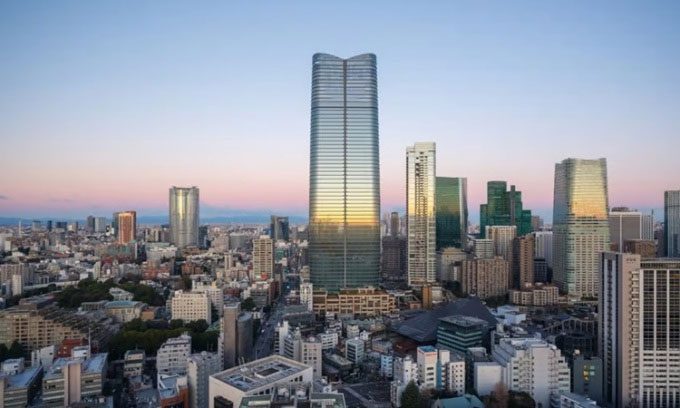The Mori JP Tower, standing at over 325 meters, is equipped with multiple systems designed to minimize strong vibrations and can withstand earthquakes measuring up to 9 on the Richter scale.
Mori JP Tower has become the tallest building in Japan. With a height of 325.2 meters in Tokyo, the building is designed to reduce energy consumption from the grid, featuring numerous sustainable elements and seismic resilience. Designed by Pelli Clarke & Partners, Mori JP Tower is located in Azabudai Hills, a new district that includes ample green spaces and buildings by Heatherwick Studio, along with two other skyscrapers, as reported by New Atlas on March 19.

Mori JP Tower has 64 floors. (Photo: Jason O’Rear).
The new skyscraper features a glass façade that evokes the symmetry of a lotus flower, with four curved glass sides resembling petals. The building’s exterior is illuminated by integrated light strips designed by the American firm L’Observatoire International, allowing the structure to glow harmoniously at night. Inside, the tower comprises 64 floors, combining residential and office spaces.
While Mori JP Tower is the tallest building in Japan, it is not the tallest structure overall. That title belongs to the Tokyo Skytree, which stands at 634 meters. Additionally, the Tokyo Tower, at 332.9 meters, is also taller than Mori JP Tower. Both of these are broadcasting and observation towers and do not qualify for height rankings by the Council on Tall Buildings and Urban Habitat since they do not meet the criteria of having at least 50% of their area occupied.
In fact, the height of Mori JP Tower may not seem impressive when considered alone. The building ranks 134th in the world in terms of height, but it is a remarkable structure given the construction challenges in a seismically active region like Tokyo. According to the contractor, Mori, the building will continue to operate normally even during a strong earthquake measuring 9, similar to the Great East Japan Earthquake of 2011.
To ensure the skyscraper’s stability, steel pipe piles filled with high-strength concrete and several damping systems have been installed to reduce swaying. Additionally, the building includes an emergency shelter with a capacity for 3,600 people and a storage area for essential supplies in case of disasters.
“High-strength steel and concrete are used to maintain the structure’s balance. We also installed vibration control equipment in key areas, effectively reducing vibrations during earthquakes, leading to enhanced resistance to strong shaking. Furthermore, a large-scale device called an active mass damper helps limit swaying at the top of the building during strong winds,” Mori stated.
All electricity used by the building comes from renewable energy sources, with heat harnessed from the sewage system. The building also collects and processes rainwater for irrigation of green spaces, while wastewater from residential units is collected and reused in the bathrooms of the office floors.


















































